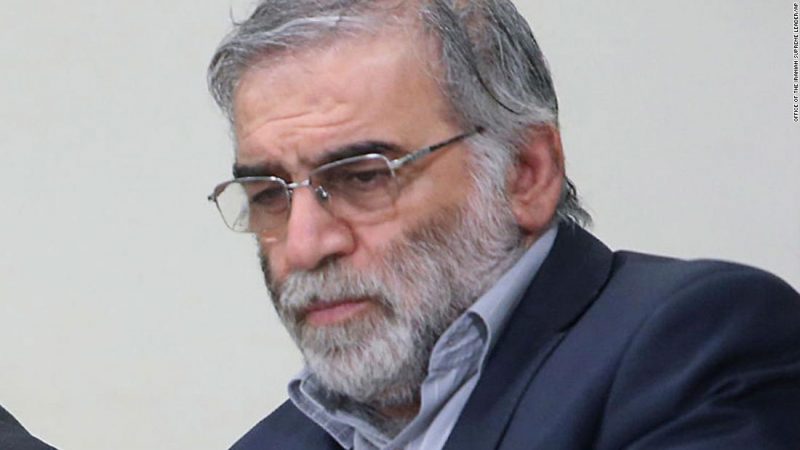
Remarkable detail of the plot to kill an Iranian nuclear scientist emerged on Saturday, a day after the assassination of Mohsen Fakhrizadeh reverberated around the world.
Sixty two people were involved in the scheme, according to Mohamad Ahwaze, an Iranian journalist who exposed the extent of the COVID-19 pandemic in his country.
Ahwaze said he had obtained leaked Iranian information.
Iranian officials have blamed Israel’s Mossad for the assassination. One American official and two other intelligence officials also told the New York Times that Israel was behind the attack.
Ahwaze said that 12 members of the team, who he described as being highly trained and assisted by ‘security and intelligence services abroad’, were deployed to the city of Absard, 50 miles east of Tehran.
The mountain retreat of 10,000 people is where many Tehranis have second homes, and Fakhrizadeh, 59, had a villa there.
Another 50 people, Ahwaze said, helped with logistical support. He did not specify whether they were in Iran, or abroad.
The team had been watching Fakhrizadeh, and knew that he was going to be driving from Tehran to Absard on Friday.
They planned the attack for a roundabout in Absard, at the foot of a tree-lined boulevard which enters the city.
A Hyundai Santa Fe with four passengers, four motorcyles and two snipers were waiting for him at the scene of the ambush, along with a booby-trapped Nissan pickup.
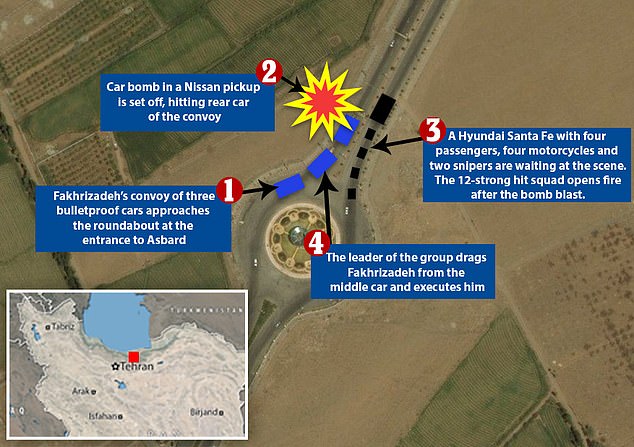
How the attack unfolded, according to Mohamad Ahwaze, an Iranian journalist who exposed the extent of the COVID-19 pandemic in his country
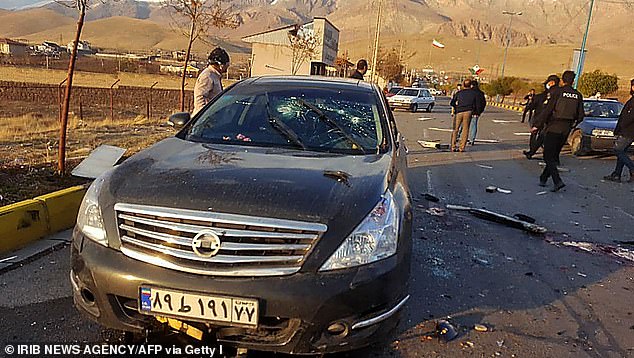
Fakhrizadeh was shot and killed while his convoy (pictured) was arriving in the city of Absard
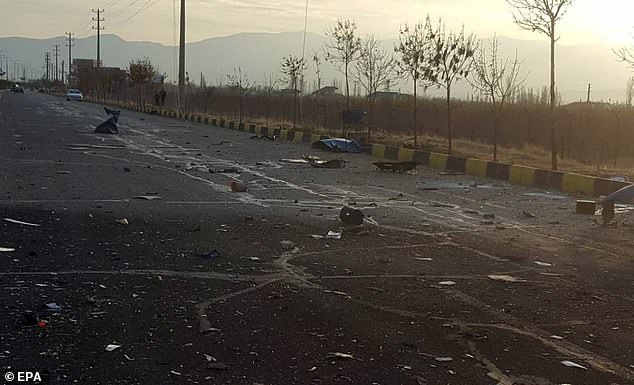
Iranian state TV released several images of the scene, showing shards of glass and metal
Half an hour before Fakhrizadeh’s convoy of three bulletproof cars arrived, the electricity was cut off to the area, Ahwaze reported.
The team were in place when the first car passed the roundabout.
As the third car passes, the Nissan explodes, damaging electricity poles and transmitters, according to a state TV report from the area on Friday night.
The force of the explosion from the bomb hurled debris at least 300 meters, according to state television.
The second car, containing Fakhrizadeh, was then shot at by the 12 assassins, including two snipers.
The gunmen with the hit squad opened fire on the cars, and an intense gunfight ensued, according to Sepah Cybery, a social media channel affiliated with the Islamic Revolutionary Guards Corps.
Ahwaze tweeted: ‘According to Iranian leaks, the leader of the assassination team took Fakhrizadeh out of his car and shot him and made sure he was killed.’
The hit squad then vanished, having sustained no losses to their team, Ahwaze reported.
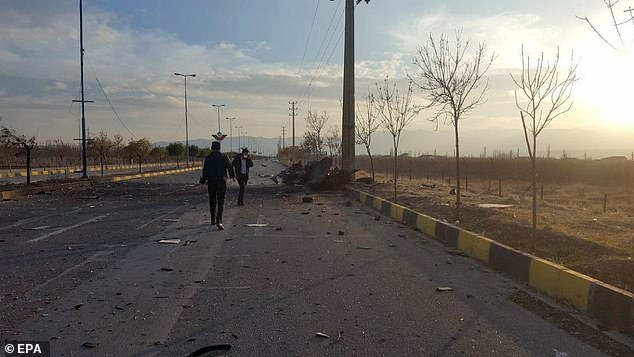
Those wounded in the attack (the aftermath, pictured) were rushed to a local hospital
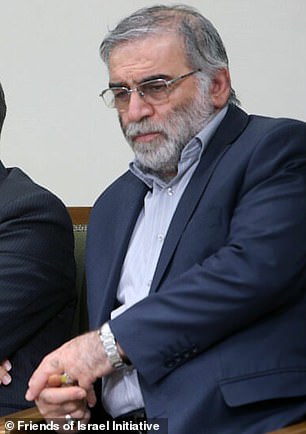
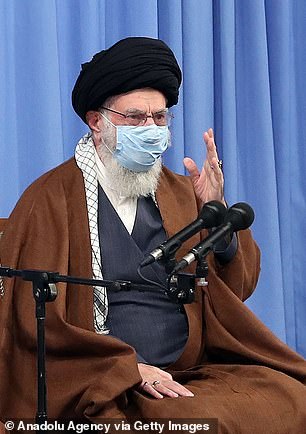
The death of Fakhrizadeh (left) was mourned by Iran’s Supreme Leader Ayatollah Ali Khamenei
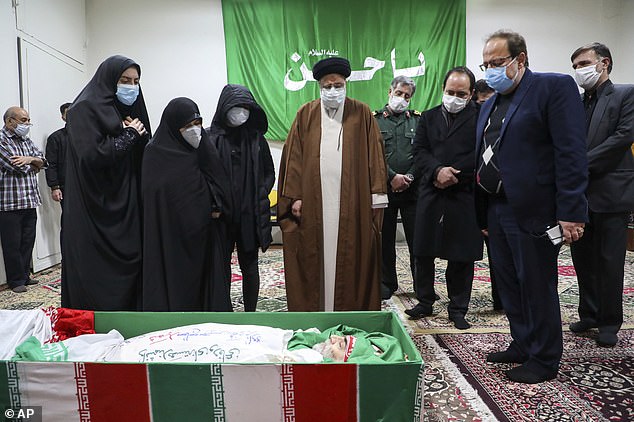
Iran’s Judiciary Chief Ayatollah Ebrahim Raisi pays respect to Fakhrizadeh on Saturday
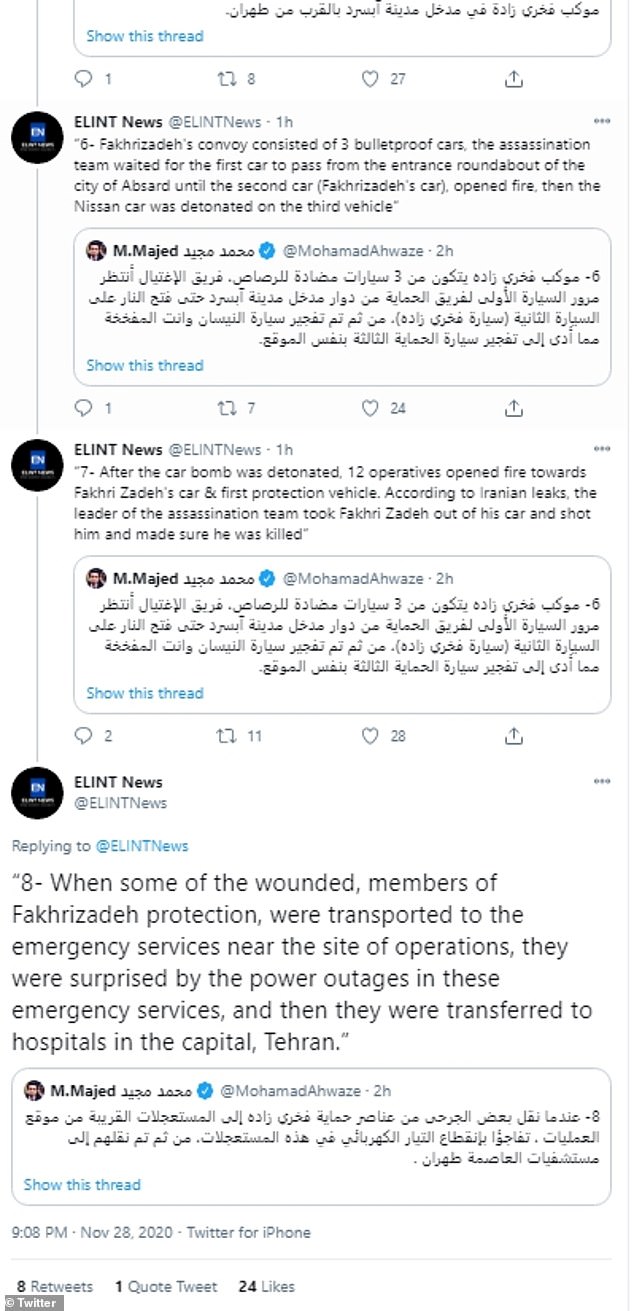
Residents told state television that they heard the sound of a big explosion followed by intense machine gun fire as Fakhrizadeh’s bodyguards fought back.
They knew the man they were protecting had for years been Mossad’s number one target.
A police helicopter landed in the area to transport Fakhrizadeh and others to the hospital, according to a video posted by a resident who narrates the video saying ‘several people are dead.’
When members of Fakhrizadeh’s security detail arrived in hospital, they were surprised to find that there was no electricity, after the power had been cut. They are then transported to Tehran.
At 10:28am EST (7:30pm local time) on Friday, the Iranian foreign minister, Javad Zarif, said that ‘an eminent Iranian scientist’ had been killed, with the suspected aid of Israel.
Fakhrizadeh’s body lay in a flag-draped, open coffin at a mosque on Saturday in central Tehran, where Iran’s chief justice, Ebrahim Raisi, prayed over his body in a public spectacle of mourning.
His death sent tensions in the region skyrocketing as Iran accused Israel of trying to provoke a war by killing the scientist – who Israeli prime minister Benjamin Netanyahu once called out in a news conference saying: ‘Remember that name’.
Iran’s Supreme Leader Ayatollah Ali Khamenei on Saturday called Fakhrizadeh ‘the country’s prominent and distinguished nuclear and defensive scientist.’
Khamenei – who has the final say on all matters of state – said Iran’s first priority after the killing was the ‘definitive punishment of the perpetrators and those who ordered it.’ He did not elaborate.
And, in an intervention that risks inflaming conflict even further, a former head of the US’s Central Intelligence Agency labelled the assassination a ‘criminal’ act and branded it ‘highly reckless’.
John Brennan – who was director of the CIA from 2013 to 2017 under the administration of president Barack Obama – said he did not know who was to blame for the murder of Fakhrizadeh but labeled it a ‘criminal’ act.
President Hassan Rouhani said Israel was to blame in a televised speech on Saturday, and said Iran would retaliate for the killing of Fakhrizadeh at ‘the proper time’.
Rouhani said: ‘Our people are wiser than to fall in the trap of the Zionist regime (Israel).
‘Iran will surely respond to the martyrdom of our scientist at the proper time.’
In a letter to U.N. Secretary-General Antonio Guterres and the U.N. Security Council on Friday, Iranian envoy, Majid Takht Ravanchi wrote: ‘Warning against any adventuristic measures by the United States and Israel against my country, particularly during the remaining period of the current administration of the United States in office, the Islamic Republic of Iran reserves its rights to take all necessary measures to defend its people and secure its interests.’
Friday’s attack also came just days before the 10-year anniversary of the killing of Iranian nuclear scientist Majid Shahriari.
Tehran also blamed that attack on Israel, coming as it did at the height of Western fears over Iran’s nuclear program.
The United States military on Friday said it had deployed the aircraft carrier USS Nimitz to the Persian Gulf alongside other warships in order to provide ‘combat support and air cover’ for soldiers withdrawing from Iraq and Afghanistan.
The decision to deploy the Nimitz to the Persian Gulf was reportedly made before the killing of Fakhrizadeh.
Israel has so far declined to comment on the death of Fakhrizadeh-Mahabadi.
Israel has long been suspected of carrying out a series of targeted killings of Iranian nuclear scientists nearly a decade ago.
Fakhrizadeh-Mahabadi was named in UN sanctions resolutions because of his work as head of Iran’s Organization of Defensive Innovation and Research group in 2007.
The US charges that the organization – known by its Farsi acronym SPND – oversees nuclear-relevant research for Iran and is active in the training of new scientists.
Israeli Prime Minister Benjamin Netanyahu named Fakhrizadeh-Mahabadi as boss of the SPND during a news conference in 2018.
In 2007, he was revealed to be the chairman of the Field for the Expansion of Deployment of Advanced Technology (FEDAT) in a leaked Iranian document.
The FEDAT was the cover name for the organisation behind Iran’s nuclear weapons programme.
The leaked document purported to show the country’s four-year plan to develop a uranium deuteride neutron initiator.
Fakhrizadeh led Iran’s so-called ‘Amad,’ or ‘Hope’ program.
Israel and the West have alleged it was a military operation looking at the feasibility of building a nuclear weapon in Iran. Tehran long has maintained its nuclear program is peaceful.
The International Atomic Energy Agency says that ‘Amad’ program ended in the early 2000s. IAEA inspectors now monitor Iranian nuclear sites as part of Iran’s now-unraveling nuclear deal with world power.
Senior Israeli officials this week predicted ‘a very sensitive period’ in the coming weeks – ahead of President-Elect Joe Biden’s inauguration.
In a bid to be cautious, Israel is reportedly preparing for potential retaliation from Iran, Axios reports.
Earlier this month, Trump held an Oval Office meeting where he was ‘talked out of’ launching strikes on Iran after a previous UN report showed a massive increase in nuclear stockpiles in breach of the Obama-era pact which Trump abandoned in 2018.
Defence sources told The New York Times that Trump asked for options on a bombardment – likely to have targeted Iran’s foremost nuclear facility, Natanz.
And just last week, a report by the UN’s International Atomic Energy Agency (IAEA) showed Iran has fired up advanced uranium centrifuges installed at its underground Natanz site.
Tehran was revealed to be pumping nuclear fuel into high-tech IR-2m machines at Natanz, in contravention of an international deal to only use first generation IR-1 machines.
The assassination of Fakhrizadeh-Mahabadi has lead many to speculate that he is ‘Iran’s nuclear Qassem Soleimani’.
Soleimani, a major general in the Islamic Revolutionary Guard Corps was assassinated in a US drone strike in January this year.
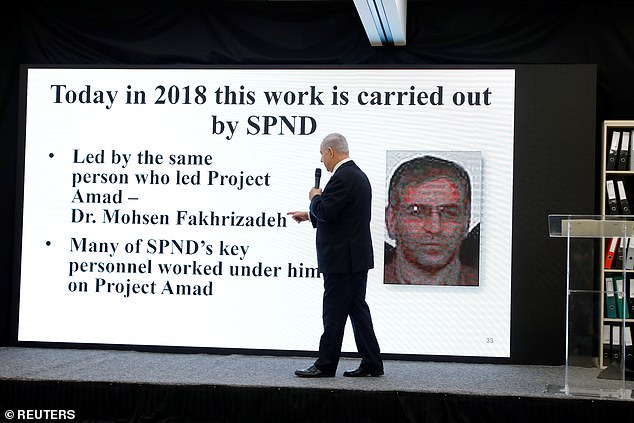
Israeli Prime Minister Benjamin Netanyahu once warned the world to ‘remember that name’
A spokesperson for the Atomic Energy Organization in Iran stressed that no accident had occurred and all scientists were safe and well.
The deputy leader of Lebanon’s Iran-backed Hezbollah movement said on Friday that the response for the assassination of Iranian scientist Mohsen Fakhrizadeh was in Iran’s hands.
‘We condemn this heinous attack and see that the response to this crime is in the hands of those concerned in Iran,’ Sheikh Naim Qassem said in an interview with Al Manar television.
He said Fakhrizadeh was killed by ‘those sponsored by America and Israel’ and said the assassination was part of a war on Iran and the region. Iran pointed the finger at Israel after Fakhrizadeh was killed in an ambush near the Iranian capital Tehran on Friday.
Israel declined to comment.
***
By News Agencies
Published by ICH
Republished by The 21st Century
The views expressed in this article are solely those of the author and do not necessarily reflect the opinions of 21cir.
[Top photo: In this picture released by the official website of the office of the Iranian supreme leader, Mohsen Fakhrizadeh, right, sits in a meeting with Supreme Leader Ayatollah Ali Khamenei in Tehran, Iran, Jan. 23, 2019. Fakhrizadeh, an Iranian scientist that Israel alleged led the Islamic Republic’s military nuclear program until its disbanding in the early 2000s was killed in a targeted attack that saw gunmen use explosives and machine gun fire Friday Nov. 27, 2020, state television said. Two others are unidentified. (Office of the Iranian Supreme Leader via AP)]
